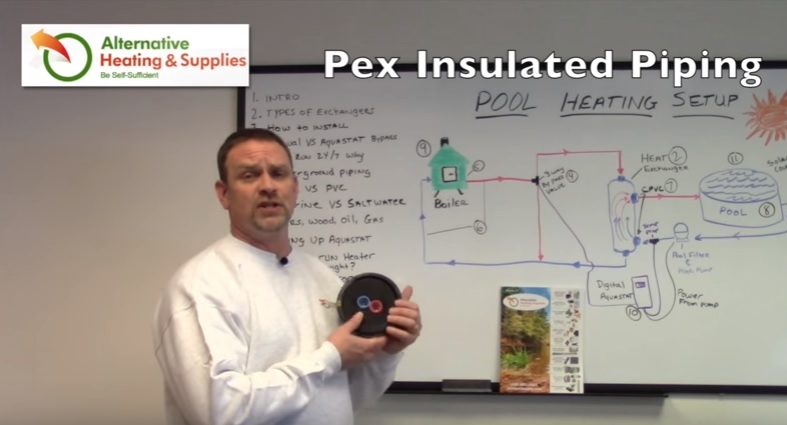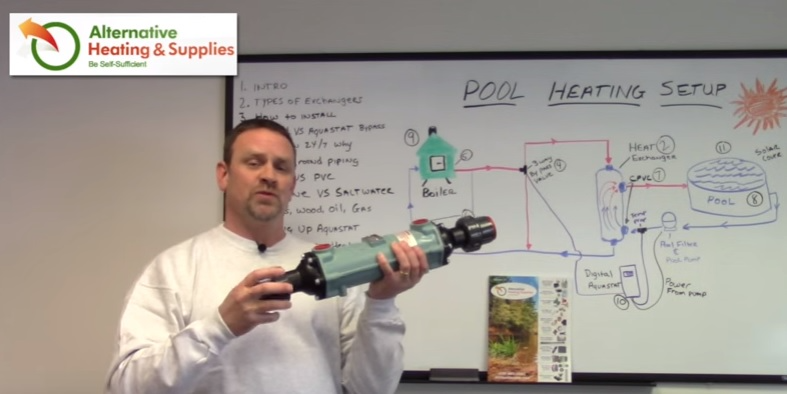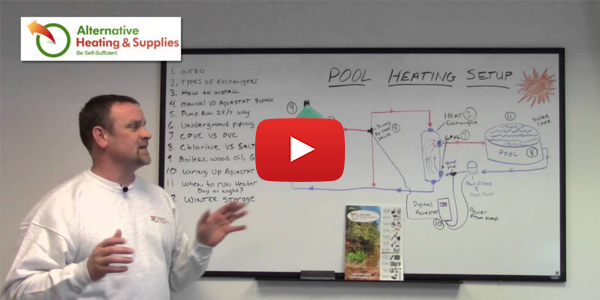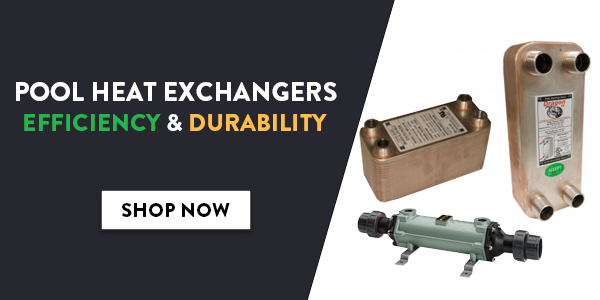The Complete Wood Boiler Installation Guide for Swimming Pools
Posted by SEBASTIAN ZOTA
This is another Alternative Heating & Supplies episode on swimming pool setup and in this blog post we are going to talk about how you can hook up the boiler to the swimming pool, the difference between chlorine and salt water pools, and the difference between using CPVC and PVC in pools. Find out all the details you need to know to use a boiler to heat up your pool water.
How to Install the Pool Heat Exchangers
I have a wood boiler drawn in the picture and that's traditionally what my base is from is outdoor wood boilers or indoor, or pellet stoves, or boilers of those kinds, alternative heating systems.
What Type of Boiler Can You Use to Heat up Your Pool
You can hook your swimming pool up to your indoor, oil-fired boiler, natural-gas boiler, propane boiler, anything that you have in your traditional heating system. A boiler is a boiler, it just heats water, it's just that simple.
So, even if you don't have a wood boiler, and you have a traditional heat inside the heating boiler, you can hook this up to your swimming pool.
How Can You Hook Up Your Boiler to Heat Your Pool
And how you're gonna do that is that you're basically going to run 2 PEX lines underground. In this case, it's an underground insulation that's gonna come from your house, and you're gonna run a system like this which keeps the 2 pipes your boiler water warm in the ground, and it's gonna send it to this heat exchanger.

PEX Insulated Piping
Now, in a traditional winter application, which is what these boilers are usually used for, it's really important that we keep them very well insulated in the ground because it's freezing outside.
In the summer when we're heating pools, heat loss in the ground is not as important. So, an option to save you quite a bit of money, this is about $6 a foot, you can also take two PEX lines, and put them in a three-inch PVC pipe, and run that on the ground. That'll save you probably $3, $4 a foot. It doesn't have any insulation factor, but in the summer when we're at the heating pool, it's not that important that we lose too much heat in the ground. We're not really concerned with that.
Manual versus Aquastat Bypass
A lot of people ask me, "Well, instead of using an Aquastat to control the temperature of the pool water why can't I just do it manually, turn it on and turn it off?" You can.
The only problem that I've noticed with my own experience with my wife and kids, is that, when the pool temperature is at 89 drops out to 87, I hear it in the ways of, "Dad, the pool is cold," or "Why is the pool cold? I don't wanna go in it," and it's only two degrees.
When the pool difference is that much, and when you when you start to spoil the kids and the wives, and everybody's happy with the pool temperature at 89, and then you take away a couple degrees, it doesn't go very well.
So, manual, which I've also tried, did not work very well with me. The other problem with the manual setup is that we turn it on and you forget to turn it off, and the pool water gets up to 91, 92 degrees which is great for the first 2 seconds you're in, but on a hot day, it's not as comfortable.
89 degrees, even on a hot day, is very comfortable in the summer. It's kind of what I would call "Florida swimming." It's enjoyable to get in, however, you go 87 on a hot day, it's refreshing but on a cold day, it's not.
And then vice versa, you go to 92, it is enjoyable on a cold day but it's not very comfortable on a hot day. So that's why 89 seems to be perfect and that's why I like it.
So, you can do the manual if you want, but I'm pretty sure that you're gonna go back into the digital aquastat, and take your mind at ease, and not worry about that getting too cold or getting too hot, keeping the family happy.
Running Your Pump 24/7
I'm gonna go to why a pump should run 24/7. In the wood boiler application, the wood boiler application only, the reason why we wanna keep this pump circulating all the time with the bypass is that when a boiler, especially in the summertime, the hotter water will rise to the top of the tank. And in the barrel of the chamber, which is surrounded by the hot water, is the fire and the top of the fire chamber is the hottest part of it.
So you got both elements, the water and the hottest part of the fire chamber at the very top, which is creating the water on the top to heat up very quickly, and if you're not circulating it, it could bubble, or boil over, or percolate.
This is a common problem for most outdoor wood boilers. Some boilers don't have the problem as much. But if you keep the thing circulating all the time, it will prevent you from boiling or percolating your boiler which, in the long run, could save you some of the electronics or anything that's running the machine from overheating, melting, or causing problems.
CPVC versus PVS
Now, I wanna talk about the difference between CPVC and PVC. There is a big difference. Most of you guys are all common with or are familiar with the white PVC. It's the plumbing inside your house. It makes great plumbing. It works fine, its longevity is excellent. It's just a good product.
However, it does not handle the heat very well. Most pool systems use a PVC. The pool systems are not needed to have the CPVC because the CPVC, the only difference of the CPVC compared to the PVC is that the temperatures in which it can be handled.
It's more or less made from the same product. The CPVC is designed to handle the temperatures much better.

CPVC Heat Exchanger
So, when you are plumbing this into your house or your pool, your tubing shell, in this case, this one already comes with unions and they're made from a CPVC, and as you notice in your pool, it's gonna be a white PVC or a flexible PVC kind of pipe.
So, what I least recommend is you go back as far as you can and add the CPVC because, again, if the water from the filter stops circulating and the heater water is still flowing, the water inside this heat exchanger and these pool lines are gonna heat up dramatically. They're gonna get up in the excess of 180 degrees and maybe even higher because, in the summer, these boilers seem to run hot. And what will happen is, if you stay with PVC and this happens, the PVC will actually twist and dormant and you'll start getting leaks in your system on the poolside.
This side of the heat exchanger is usually done through PEX, and PEX has no problem handling those temperatures. So, what we recommend is from the filter, at least, to the heat exchanger, you're using a CPVC. You can pick it up at any of your local plumbing stores. Just ask for it, "CPVC."
And from the heat exchanger, as far as you can go back to the pool, with PVC as well. That'll save you a lot of problems, and I can talk, from experience once again, that just do it right the first time, it'll make your life a lot easier.
Chlorine versus Saltwater Pool
Now, we're gonna go into the difference between chlorine and saltwater pools. The difference is, obviously, the people who have the chlorinated pools, you add your chemicals, you add your treatments, you add your pH enhancers and all that stuff. A lot of chemicals, a lot of expense and if you read your "Earth - World Magazines" and your things, we're finding out that chlorine is actually really bad for us as humans.
If you're gonna convert over to a saltwater pool, again, I already talked about it earlier, move to the cupro-nickel
If there's any thought of you having a chlorinated pool and in the near-future moving into a saltwater pool or spa, go right to the cupro-nickel. Much more longevity, much more durable and resilient.
Boilers, Wood, Oil or Gas
Boilers, wood, oil or gas. In this system, and most of my customers that I deal with or have the outdoor wood boilers. But, I wanna let everybody know that if you have a traditional indoor boiler gas, oil, propane, you can also do this.
All you gotta do is run these lines from your house to your pool. It's not as much work as you're probably hemming and hawing about. Just running these two lines, one inch, two from your boiler. We mount a pump onto your boiler which circulates the water back and forth to the pool.
It is a lot cheaper than adding a heating system to your pool, and a tank and a propane tank. This is considerably cheaper, and a lot less work, and you don't need another fuel source.
Check out the next video where I will be talking about how to install and set the aquastat of a boiler.


Also, check out our kits, check out our catalog on our website, and our catalog, which also can be found at the very top of our website in the center and you can download it. Or just give us a call, we'll put one in the mail for you.
